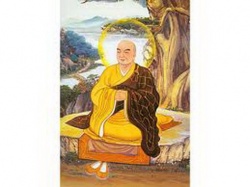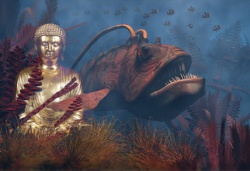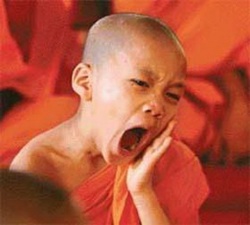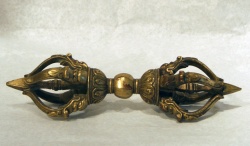Wisdom from the realm of the Nagas
Dear Prof. Harvey,
A timeline of the earliest sources on Nagarjuna's dragon palace adventure looks something like this:
1) ca. 406 -- Sengrui's 僧叡 (352-436) preface to Kumarajiva's translation of the Great Perfection of Wisdom Treatise (Dazhidu lun = DZDL):
"Nagarjuna availed himself of the light of the dragon palace to illumine wisdom in search of the profound, and he devoted himself to the study of the secret depth in order to exhaust the marvel of the subtle words [of the Prajñāpāramitā?]. Then, with the canon of wisdom as basis he composed this exposition [of the DZDL]" (trans. following Shih 1981, 744, with modifications).
假照龍宮, 以朗搜玄之慧; 託聞幽祕, 以窮微言之妙. 爾 乃憲章智典, 作茲釋論 (T no. 2145, 55: 74c; T no. 1509, 25: 57a).
This is the earliest source that might be saying Nagarjuna retrieved the Perfection of Wisdom Sutras from the dragon palace, but this interpretation depends on what Sengrui meant by "zhidian 智典" (canon of wisdom). Robert Shih (1981. “The Preface to the Ta Chih Tu Lun.” Zhongyang yanjiu yuan guoji Hanxue huiyi lunwen ji 中央研究 院國際漢學會議論文集, vol 4, 735-50) understands "zhidian" to mean the 25,000-line Perfection of Wisdom sutra, upon which the DZDL was based, but "zhidian" may just mean the Mahayana corpus in general.
2) ca. 409 -- Tanying's 曇影 (348-418) preface to Kumarajiva's translation of Nagarjuna's Middle Treatise:
"At that time there was a great man named Nāgārjuna. When he went to the ocean palace he attained the forbearance of birthlessness. His mind relying on the Origin, he brought about the prosperity of the teaching bequeathed [by the Buddha]. Therefore, he composed [this] treatise to bend [extreme views] to the middle."
時有大士, 厥號龍樹. 爰託海宮, 逮無生忍. 意在傍宗, 載隆遺教. 故作論以折中 (T no. 2145, 55: 77a-b).
3) ca. 408-416 -- Huiyuan's 慧遠 (334-416) preface to his abridged version (from 100 scrolls to 20) of the DZDL:
"When he proceeded to the dragon palace, there was no important canon or secret text that he did not master. When the roots of his impediments had been pulled up, then his name crowned the stages of the [[[bodhisattva]]] path, and by his virtue he became endowed with the three forbearances. Only then did he open up the nine fords in the mighty abyss and, befriending the scaly species, roam together with them" (trans. following Robinson 1967, 201, with modifications).
及至龍宮, 要藏祕典, 靡不管綜. 滯根既拔, 則名冠道 位, 德備三忍. 然後開九津於重淵, 朋鱗族而俱遊 (T no. 2145, 55: 75b-c).
For more on this preface see Richard Robinson, 1967, _Early Madhyamika in India and China_, esp. pp. 200-205.
4) ca. 472 -- Account of the Causes and Conditions of the Dharma- Treasury Transmission (Fu fazang yinyuan zhuan 付法藏因緣傳, T no. 2058):
A great dragon bodhisattva pitied Nagarjuna like this, and with his divine power took him into the the great ocean. Arriving at his palace, he opened seven-jeweled coffers and from them gave Nagarjuna the immeasurably wonderful dharma of the profound scriptural canon of all the vaipulyas. Within ninety days [[[Nagarjuna]]] thoroughly understood a great many; his mind deeply penetrated them and he substantially obtained their true benefit.
The dragon knew his mind and asked him, “Have you read all of the scriptures or not?”
Nagarjuna answered, “Your scriptures are countless; they cannot be grasped completely. Those which I have read are already ten times [the number of scriptures in] Jambudvipa.”
The dragon king said, “In the Heaven of Thirty-three, Sakra Devanam- Indra has a billion times more scriptures than in this palace....”
At that time Nagarjuna received all the scriptures, thoroughly penetrated them and understood their single aspect. Deeply entering birthlessness, he became endowed with the two forbearances. The dragon knew that he had been awakened to the Way, so sent him from the palace.
大龍菩薩, 愍其若此, 即以神力, 接入大海. 至其宮殿, 開七寶函, 以諸方等, 深奧經典, 無量妙法, 授與龍樹. 九十日中, 通解甚多, 其心深入, 體得實利. 龍知心念, 而問之言, "汝今看經, 為遍未耶?" 龍樹答言, "汝經無 量, 不可得盡. 我所讀者, 足滿十倍, 過閻浮提." 龍王 語言, "忉利天上, 釋提桓因, 所有經典, 倍過此宮, 百千 萬倍...." 爾時龍樹, 既得諸經, 豁然通達, 善解一相. 深 入無生, 二忍具足. 龍知悟道, 還送出宮 (T no. 2058, 50: 318a).
On the provenance of this text see especially Maspero, Henri. 1911. “Sur la date et l’authenticité du Fou fa tsang yin yüan tchouan.” In Mélanges d’Indianisme offerts par ses élèves à M. Sylvain Lévi, 129-49. Paris. Maspero argues convincingly that there was more than one edition of this text circulating in medieval China; his argument that the extant version dates to the second half of the 6th century is less convincing. There's good reason to believe that there *was* a text of this title in late fifth-century China, though we're not sure how much of the current text is the same.
5) late-5th or 6th century -- the separately circulating biography of Nagarjuna, wrongly ascribed to Kumarajiva (Longshu pusa zhuan 龍樹菩 薩傳, T no. 2047):
All the extant versions of this text say basically the same thing as the Dharma-Treasury Transmission: that Nagarjuna received the "immeasurably wonderful dharma of the profound scriptural canon of all the vaipulyas" (諸方等深奧經典無量妙法) from the dragon palace.
This biography as a whole probably derives from the Dharma- Treasury Transmission. See Li Rongxi, trans. 2002. “The Life of Nāgārjuna Bodhisattva.”
In Lives of Great Monks and Nuns, trans. Albert A. Dalia and Li Rongxi, 17-30. Berkeley: Numata Center for Buddhist Translation and Research. Corless, Roger. 1995. “The Chinese Life of Nāgārjuna.” In Buddhism in Practice, ed. Donald S. Lopez, Jr., 525-531. Princeton: Princeton University Press.
6) Writings of Jizang 吉藏 (549-623):
Dasheng xuanlun 大乘玄論 (Treatise on the Profundity of the Mahayana), T no. 1853, 45: 77a-b -- Nagarjuna received the "vaipulya canon"
Guan wuliang shou jing yishu 觀無量壽經義疏, T no 1752, 37: 237b -- Nagarjuna received the Contemplation Scripture on [the Buddha of] Immeasurable Life (Wuliang shou guanjing 無量壽觀經, T no. 365)
Jingming xuanlun 淨名玄論 (Treatise on the Profundity of the Vimalakirti), T no. 1780, 38: 863b -- Here Jizang writes that after he moved to Chang'an in 599 he met the Dharma-master Sengtan 僧曇 (d. after 604), who had recently returned to the Chinese capital from the Central Asian oasis state of Khotan (Yutian 于闐). There in Khotan, Sengtan reported, he saw a biography of Nāgārjuna (Longshu zhuan 龍 樹傳) that read:
There are three editions of the Flower Garland in total. The large edition has verses [as numerous as] the atoms of the triple-thousand great one-thousand worlds (trichiliocosm), and chapters [as numerous as] the atoms within one of the four heavens [of the four directions]. The middle edition has 498,800 verses and 1,200 chapters. These two editions are both in the dragon palace, but Nāgārjuna did not recite them completely. He only recited the small edition, with 100,000 verses and 36 chapters.
華嚴凡有三本. 大本有三千大千世界微塵偈, 一四天下 微塵品. 中本有四十九萬八千八百偈, 一千二百品. 此 二本並在龍宮, 龍樹不誦出也. 唯誦下本, 十萬偈三十六 品 (T no. 1780, 38: 863b).
Jizang then adds that according to Bodhiruci, it was six hundred years after the death of the Buddha when Nāgārjuna retrieved the smallest edition of the Flower Garland from the dragon palace.
Jizang mentions the Nagarjuna-in-dragon-palace story in other places, but these basically repeat what I've cited here.
From this point Chinese authors commonly assert that Nagarjuna got the Avatamsaka from the dragon palace, in addition to the vaipulya scriptures more broadly.
As for the Prajnaparamitas, I haven't seen a Chinese text stating that Nagarjuna received the 100,000-line version in particular. He was usually associated with the 25,000-line PPS, since the DZDL is a commentary on that (and was "translated" together with it). But, depending on how we read "zhidian 智典," the earliest source for the idea that Nagarjuna brought the Prajnaparamitas from the dragon palace might be Sengrui's DZDL preface of ca. 406.
Hope this background is useful, even if it doesn't really answer your question! An excellent opportunity for me to procrastinate, anyway...
Stuart Young Princeton University





